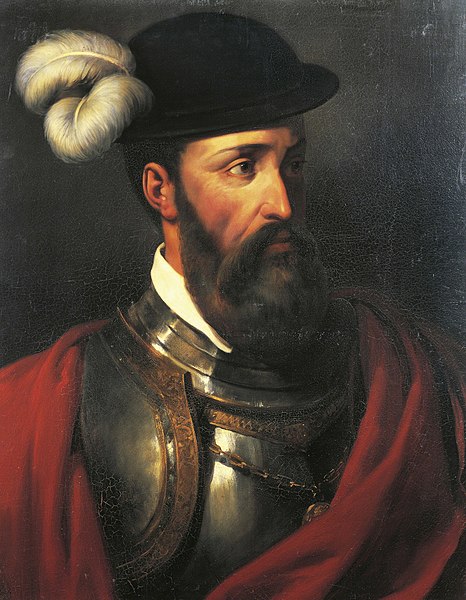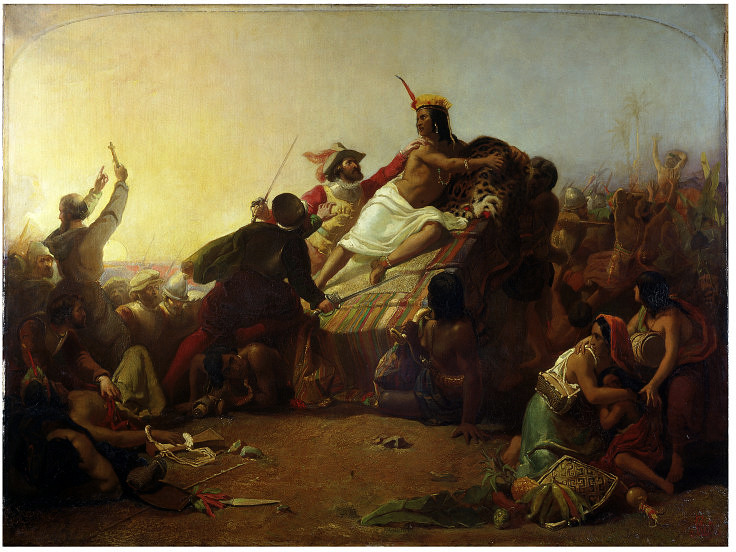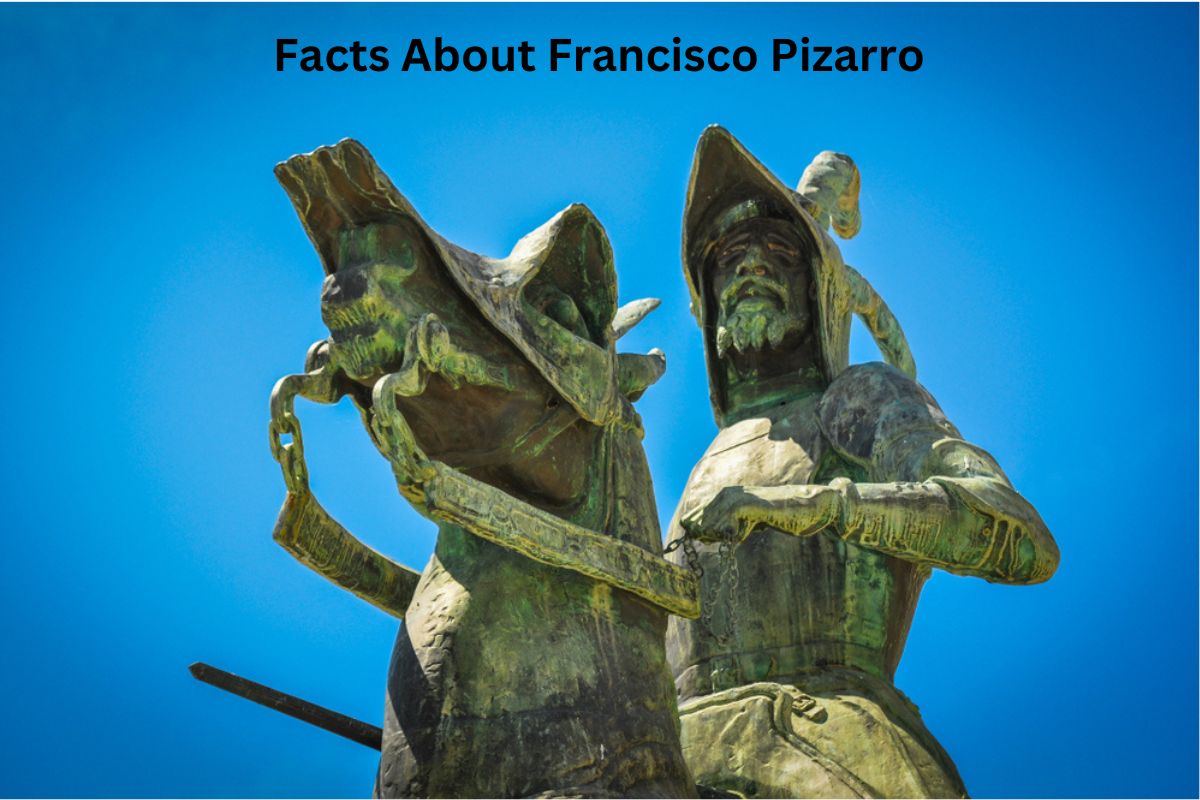Francisco Pizarro, born around 1471 in Trujillo, Spain, emerged as a notable figure during the Age of Exploration.
Rising from humble beginnings, he became a renowned Spanish conquistador, renowned for his conquest of the Inca Empire in what is now Peru.
Pizarro’s expeditions, marked by both triumphs and controversies, left an indelible mark on the history of colonialism in the Americas.
His actions played a pivotal role in reshaping the course of civilizations, triggering debates about the ethics and consequences of conquest and colonization.
Francisco Pizarro Facts
1. Born around 1471 in Trujillo, Spain
Francisco Pizarro was born in the town of Trujillo, located in the Extremadura region of Spain. His exact birth date is not well-documented, but it is estimated to be around 1471.
Also Read: Francisco Pizarro Timeline
Pizarro was born into a humble background; his parents were Gonzalo Pizarro Rodríguez de Aguilar, a colonel of infantry, and Francisca González Mateos, a woman of modest means.
Pizarro grew up in poverty and had limited access to formal education, which would significantly influence his later path in life.

2. Conquistador who conquered the Inca Empire in Peru
Francisco Pizarro became one of the most famous Spanish conquistadors of the 16th century. He is best known for leading the conquest of the Inca Empire, a pre-Columbian civilization located in the Andean region of South America, specifically in what is now modern-day Peru.
Pizarro’s conquest was marked by a combination of military prowess, strategic maneuvering, and political manipulation. He arrived in the Inca Empire during a time of internal strife and took advantage of the divisions among the Inca rulers.
Pizarro’s small group of conquistadors managed to capture the Inca Emperor Atahualpa, which eventually led to the downfall of the Inca civilization and the establishment of Spanish dominance in the region.
3. Joined Vasco Núñez de Balboa’s expedition in 1513
Before his involvement in the conquest of the Inca Empire, Francisco Pizarro gained some early experience in exploration and conquest.
In 1513, he joined the expedition led by Vasco Núñez de Balboa. This expedition was notable for Balboa becoming the first European to cross the Isthmus of Panama and reach the Pacific Ocean.
The exploration of the Pacific side of the Americas was a significant achievement and contributed to the Spanish understanding of the vastness of the New World.
Pizarro’s participation in this expedition likely exposed him to the allure of further exploration and the potential for wealth and fame in the Americas, motivating his later efforts in South America.
4. Led expeditions to South America, including failed attempts
Francisco Pizarro embarked on several expeditions to South America in his pursuit of wealth and conquest. His initial attempts to explore and conquer new territories were met with challenges and setbacks.
In 1524, he led his first expedition to the region of present-day Colombia, along with Diego de Almagro and Hernando de Luque.
This expedition aimed to find new lands and riches, but it faced difficulties due to the harsh terrain, hostile encounters with indigenous populations, and lack of resources. The expedition ultimately returned to Panama without significant success.
Undeterred, Pizarro made subsequent expeditions, often in collaboration with Almagro and Luque. These expeditions introduced him to the western coast of South America and its indigenous civilizations, including the Inca Empire.
Pizarro’s determination and persistence in the face of adversity eventually led to the planning and execution of the successful conquest of the Inca Empire.

5. Captured Inca Emperor Atahualpa in 1532
One of Francisco Pizarro’s most significant achievements was the capture of the Inca Emperor Atahualpa in 1532. Pizarro’s small group of conquistadors, numbering around 180 men, managed to ambush and capture Atahualpa during a meeting near the town of Cajamarca.
This unexpected success was achieved through a combination of strategic planning and deception. Atahualpa was taken captive, and Pizarro demanded a massive ransom of gold and silver for his release.
The Inca fulfilled their promise, providing a considerable amount of precious metals, but Pizarro still ordered Atahualpa’s execution, which deeply weakened the Inca resistance and played a crucial role in the Spanish conquest of the Inca Empire.
6. Executed Atahualpa despite receiving a ransom
After the Inca Empire paid an enormous ransom to secure the release of their emperor, Francisco Pizarro still ordered Atahualpa’s execution in August 1533. The reasons behind this controversial decision are debated among historians.
Some suggest that Pizarro felt threatened by Atahualpa’s potential to rally resistance or believed that Atahualpa’s death would solidify Spanish control. Others speculate that cultural misunderstandings, political considerations, or pressure from Pizarro’s companions might have influenced this decision.
Regardless of the motives, Atahualpa’s execution was a turning point that significantly weakened the Inca’s ability to resist Spanish colonization and marked a tragic episode in the conquest’s history.
7. Founded Lima, Peru, in 1535
In January 1535, Francisco Pizarro founded the city of Lima, located on the central western coast of present-day Peru.
The city was established as the capital of the Spanish Viceroyalty of Peru, which was a significant administrative and political center for the Spanish colonial empire in South America.
Lima’s strategic location between the Andes Mountains and the Pacific Ocean made it an important hub for trade, communication, and governance. Over time, Lima grew to become one of the largest and most influential cities in the Spanish Americas.
8. Faced conflicts with other conquistadors, leading to his assassination in 1541
As Pizarro’s power and influence grew in the wake of the Inca conquest, conflicts emerged among the Spanish conquistadors vying for control over the newly acquired territories.
One of the most notable conflicts was the rivalry between Pizarro and Diego de Almagro, a fellow conquistador who had accompanied Pizarro on earlier expeditions. The tensions escalated into a violent conflict known as the “War of the Two Brothers” (la Guerra de los Dos Hermanos).
In 1541, Diego de Almagro’s forces captured and executed Pizarro’s brothers. In retaliation, Pizarro’s supporters assassinated Almagro. However, this act did not bring stability.
On June 26, 1541, a group of Almagro’s supporters, led by Juan de Rada, ambushed Pizarro at his residence in Lima and assassinated him. Pizarro’s death marked the end of an era and highlighted the often turbulent and competitive nature of the early Spanish conquests.
9. Legacy includes financing Spain’s empire with Peru’s wealth
The conquest of the Inca Empire brought immense wealth to Spain, as the Spanish conquistadors looted vast amounts of gold, silver, and other valuable resources.
This influx of wealth significantly contributed to the Spanish Crown’s ability to finance its empire and global endeavors during the 16th century.
The influx of precious metals from the Americas had profound economic effects on Europe, leading to inflation, increased trade, and changes in the global economy.
10. Controversial for the violence and impact of the conquest on indigenous populations
While Pizarro’s conquest and the subsequent colonization of the Americas brought material wealth to Spain, it also had devastating consequences for the indigenous populations of the region.
The violence, diseases, forced labor, and cultural disruption caused by the Spanish conquest resulted in the significant decline of native populations and the loss of their traditional way of life.
Pizarro’s actions and the broader impact of colonization have led to ongoing debates and discussions about the ethical and moral implications of these events, particularly from a modern perspective that emphasizes human rights and cultural preservation.
